Top Ways to Boost Your Alpaca Fiber Yield
To boost your alpaca fiber yield, focus on feeding high-quality forage with balanced minerals and supplements to promote finer, softer fleece. Select breeding stock with superior genetics and low micron counts for better fiber. Provide proper shelter and enough space to keep animals comfortable and healthy. Stick to a regular shearing schedule in spring to maintain fleece quality and encourage growth. Keep monitoring feed and fiber characteristics to make smart adjustments. There’s plenty more to explore for maximizing your alpaca fiber output.
Key Takeaways
- Provide a balanced diet with high-quality hay and supplements to enhance fiber softness and yield.
- Select breeding stock with proven fine micron fiber through genetic testing and pedigree analysis.
- Maintain proper shelter with adequate space and ventilation to reduce alpaca stress and support healthy fiber growth.
- Implement annual spring shearing to maintain fleece condition and prevent fiber matting.
- Regularly test and monitor forage and feed quality to optimize nutrition and fiber characteristics.
Understanding Alpaca Fiber Characteristics
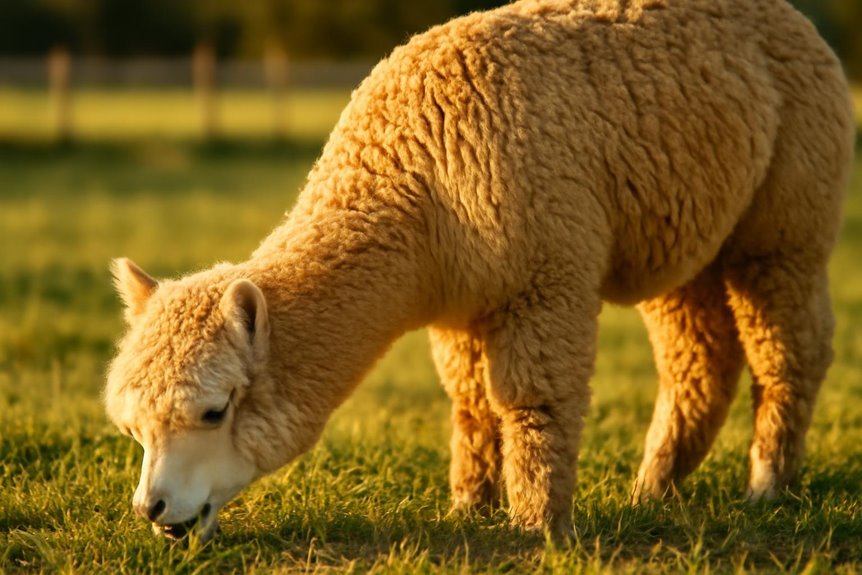
Alpaca fiber comes in two main types: Huacaya, which feels fluffy and crimped, and Suri, known for its long, silky locks. When evaluating fleece quality, the micron diameter plays an essential role; finer fibers between 18-25 microns produce softer, high-quality fiber favored in luxury textiles. Your alpaca’s health directly impacts fleece quality—healthy animals produce more abundant, finer fiber. Each alpaca yields around 2 to 5 kilograms of fleece yearly, but factors like genetics and overall well-being influence this. Alpaca fiber also offers natural luster and hypoallergenic properties, making it a premium choice for sensitive skin. Understanding these characteristics helps you focus on maintaining alpaca health and improving fleece quality, ultimately boosting your production of high-quality fiber.
Optimizing Nutrition for Quality Fleece
To get the best quality fleece from your alpacas, you need to focus on the right nutrient balance and feeding strategies. Providing high-quality hay along with tailored supplements guarantees their fiber stays soft and shiny. Keep in mind, overfeeding or poor feed choices can quickly harm fleece quality, so monitoring their diet closely is key.
Essential Nutrient Components
Three key nutritional components—quality forage, balanced minerals, and appropriate supplements—play an essential role in producing soft, lustrous alpaca fiber. Providing your alpacas with essential nutrients directly impacts their health and fleece quality, supporting robust fiber production. To optimize these components, focus on:
- Feeding high-quality grass hay to maintain alpaca health and enhance fiber appearance
- Offering camelid-specific mineral supplements tailored to fleece needs
- Monitoring forage quality regularly and adjusting diets accordingly
- Ensuring pregnant females receive nutrient-rich feed to support cria and future fiber quality
Feeding Strategies for Fiber
Building on the importance of nutrient components, focusing on feeding strategies can greatly enhance fiber quality. You’ll want to provide high-quality hay and supplements, guaranteeing the nutritional value is balanced to avoid producing coarse fiber. Alpacas need about 1.5 to 2 kg of dry food daily, mainly from grasses and premium hay, to support quality fiber growth and overall health. Regularly testing your hay and feed helps you adjust diets precisely to meet your fiber quality goals, improving micron diameter and handle. Following a structured nutrition program, informed by expert advice and industry mentors, will yield better fleece over time. Remember, quality nutrition is vital for pregnant and nursing females to guarantee their cria develop strong, quality fiber for the future.
Effective Breeding Practices for Enhanced Fiber
Although breeding alpacas for better fiber might seem complex, focusing on key practices can greatly boost your herd’s fleece quality. When breeding alpacas, prioritize quality animals with low micron counts to guarantee finer, softer fleece. You’ll want to manage breeding carefully, controlling mating and timing to maintain genetic diversity and optimize fiber traits. Here are some effective steps:
- Use genetic testing to pick superior breeding stock with excellent fiber density and luster.
- Select pairs based on strong pedigrees known for outstanding fleece quality.
- Regularly assess fleece via micron testing to guide future breeding decisions.
- Implement managed breeding to time cria births for consistent fiber improvement.
Maintaining Proper Housing and Shelter
When you provide alpacas with proper housing and shelter, you assure their comfort and protection from harsh weather. Ascertain each alpaca has at least 10–12 square feet of space in a simple, effective shelter. A three-sided design offers good ventilation while shielding them from wind and rain, which is essential for their health. Use dirt or gravel flooring to allow easy drainage and maintain comfort. Don’t forget sturdy fencing—woven wire standing 4–5 feet high—to keep your alpacas safe from predators. Regularly clean and inspect the housing and shelter for any damage or wear. Maintaining a safe, clean environment supports your alpacas’ health, directly impacting their wellbeing and fiber quality. Proper shelter is a foundational step in boosting your fiber yield.
Managing Stress and Animal Well-being
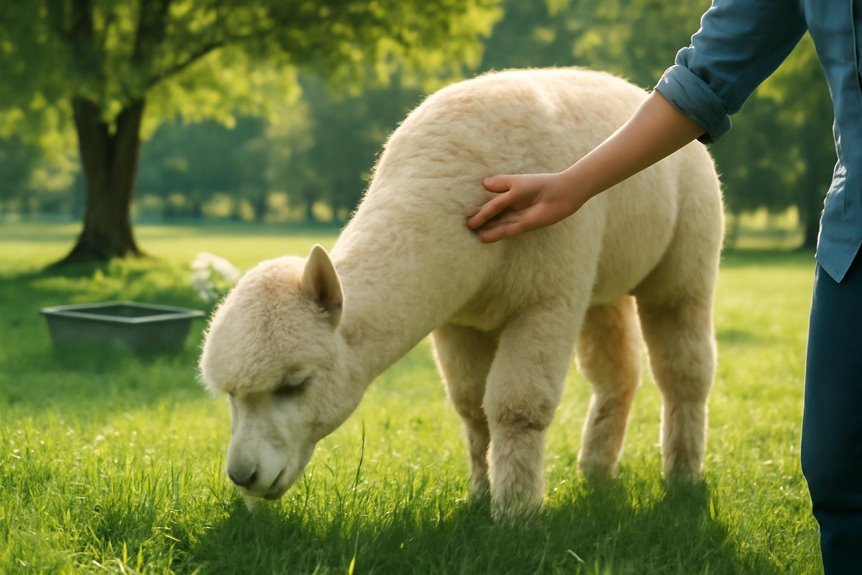
You’ll want to reduce stress factors to keep your alpacas calm and healthy, which directly boosts fiber quality. Creating a peaceful environment helps minimize anxiety and supports their well-being. By managing stress effectively, you’ll see better fleece yields and happier animals.
Reducing Stress Factors
Because alpacas are sensitive animals, managing stress is key to maintaining their well-being and maximizing fiber yield. Effective stress management helps prevent health issues that can harm fleece quality and overall productivity. To reduce stress factors, focus on these essentials:
- House alpacas with compatible companions to encourage social interaction and reduce anxiety.
- Conduct regular health checks, vaccinations, and timely shearing to avoid illness and discomfort.
- Provide adequate shelter with good ventilation and enough space to protect them from extreme weather.
- Maintain a consistent feeding and handling routine to keep alpacas comfortable and relaxed.
Promoting Calm Environments
Although alpacas are hardy animals, they thrive best in calm environments that minimize stress and disruptions. To promote a calm environment, you should guarantee ample space, proper shelter, and good ventilation to prevent overcrowding and competition. Regular interactions and gentle handling build trust, reducing anxiety and supporting better fiber quality. Maintaining quiet routines like consistent feeding schedules and daily health checks enhances their sense of security. You can also use calming techniques, such as playing soft music or sounds, to create a soothing atmosphere. By managing stress through these methods, you’ll foster well-being and improve fiber yield. Remember, minimizing stress directly impacts fiber quality, so prioritize your alpacas’ comfort to see the best results.
Implementing Regular Shearing Schedules
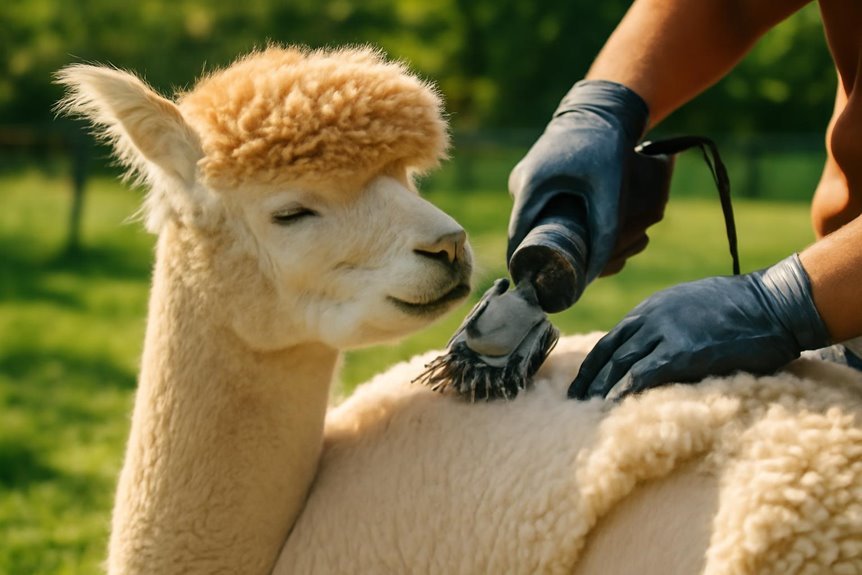
When you stick to a regular shearing schedule, typically once a year in spring, you help keep your alpacas comfortable and their fleece in prime condition. Timing shearing during mild temperatures reduces stress and prevents heat discomfort. This practice maintains hygiene and prevents fiber matting, which can lower your fleece yield. Consistent shearing also improves fiber quality by collecting clean, uncontaminated fleece, essential for higher market value in alpaca farming.
Regular spring shearing keeps alpacas comfortable and ensures clean, high-quality fleece for better yield and value.
Keep in mind these tips:
- Shear once annually in spring for ideal fleece growth.
- Avoid shearing too late to prevent excessive fleece weight.
- Document your shearing schedule to track improvements.
- Perform shearing when temperatures are mild to minimize alpaca stress.
Implementing regular shearing schedules directly boosts your fleece yield and overall fiber quality.
Selecting High-Quality Feed and Supplements
To boost your alpacas’ fiber quality, you’ll want to focus on selecting high-quality feed and supplements that meet their specific nutritional needs. As an alpaca farmer, choosing feeds like orchard hay and camelid-specific mineral formulations guarantees your animals get essential nutrients that directly support fleece production. Incorporating quality supplements into their diet can improve fiber micron diameter and density, resulting in finer, softer fleece. Avoid overfeeding or low-quality feed, as this can coarsen the fiber and undermine your efforts. Regularly testing hay and feed nutrient levels allows you to adjust the diet effectively. Don’t forget to provide clean, cool water consistently—good hydration improves digestion and boosts fiber production efficiency, making your overall fiber yield healthier and more profitable.
Frequently Asked Questions
How Much Can One Ounce of Alpaca Fiber Sell For?
You’ll find alpaca fiber pricing varies from $3 to $10 per ounce, depending on fiber quality factors like micron count and cleanliness. Market demand trends and smart selling strategies, like targeting artisans, can boost your profits considerably.
What Is the Best Alpaca Fiber?
You’ll find the best alpaca fiber comes from Huacaya and Suri breeds, with fiber quality factors like micron diameter, staple length, and brightness essential. Processing alpaca fleece carefully helps preserve these alpaca fiber types’ unique qualities.
How to Fatten up an Alpaca?
When Sarah improved her alpaca nutrition with balanced feeding techniques, she saw notable weight gain and health benefits. You should focus on high-quality hay and minerals, monitor progress, and provide clean water to fatten up your alpaca effectively.
How Much Fiber Can You Get From One Alpaca?
You can expect 2 to 5 kg of fiber production annually from one alpaca. With proper alpaca grooming, breeding strategies, and attention to fiber quality, you’ll maximize the fleece yield and maintain its commercial value over time.



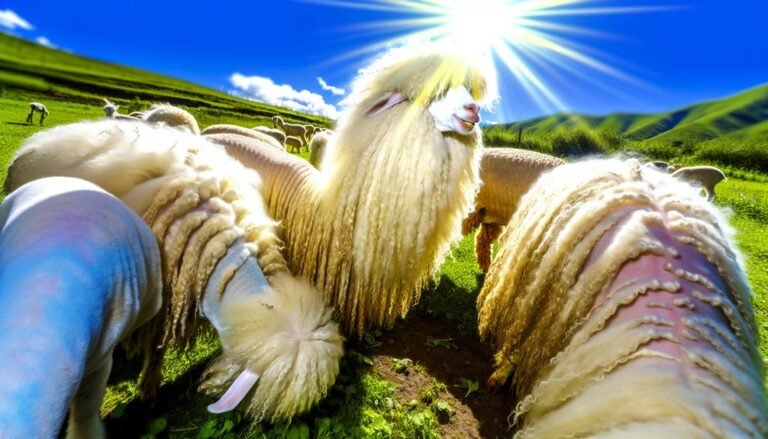


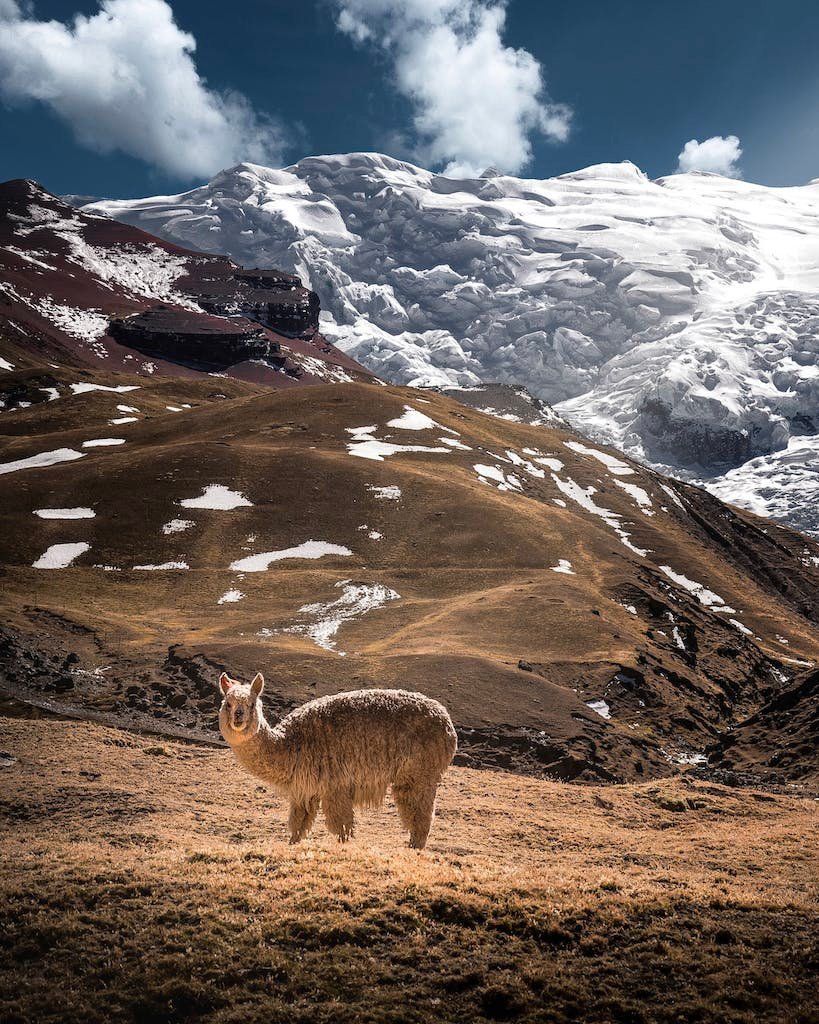
Our picks
Alpaca & Wool Felted Sole Inserts: Comfy Upgrade?
Best Alpaca Socks for Hiking: Ultimate Comfort and Durability on Trails
Best Alpaca Halter for Comfort and Control